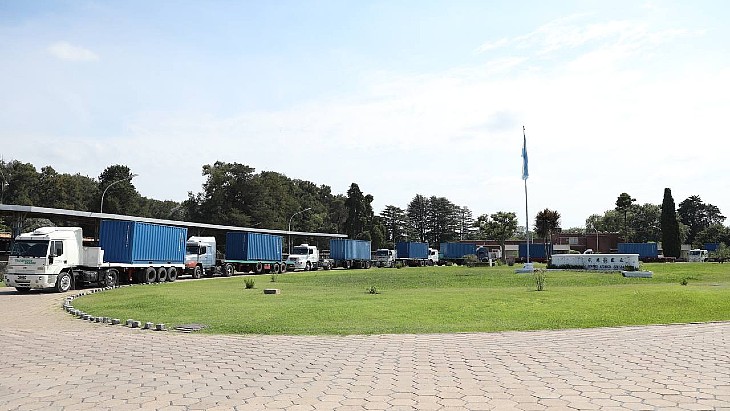Eight truck convoy delivers giant German SANS to Argentina's Neutron Beam Laboratory
12 January 2024
The small-angle neutron scattering instrument (SANS) is 33 metres long when assembled and has been donated by the German Helmholtz Zentrum Berlin institute following the closure of the BER-II reactor in 2019. It will be reassembled and come into operation when Argentina's RA-10 multipurpose research reactor begins operating.
 (Image: CNEA)
(Image: CNEA)
The instrument is used to analyse structures between 0.5 and 400 nanometers (a nanometre is one billionth of a metre) allowing materials science studies, polymers, soft matter, electrochemistry, magnetic systems and biological samples, among others, at the nanoscale.
Karina Pierpauli, executive director of the Argentine Neutron Beam Laboratory, called the arrival a "milestone" and a result of "scientific-technological cooperation between Argentina and Germany" over recent years.
According to Argentina's National Atomic Energy Commission (CNEA), the instrument has a collimation and detection system that can provide various experimental configurations and the detection tube, which operates in high vacuum, is 16 metres long and 1.5 metres in diameter.
CNEA said that Argentina was selected from a number of countries who applied to host the instrument at the end of its life-cycle at BER-II, and will give it new life using the neutron beams that the RA-10 reactor, scheduled for 2025, will produce.
The instrument was carefully taken apart in Germany during 2021 and 2022, with each step documented so it can be reassembled in the beam laboratory being built next to RA-10 at the Ezeiza Atomic Centre in Argentina. Cold assembly is due to be carried out this year.
The size of the equipment meant that eight containers were used to transport it by ship from Hamburg before it was transported by a fleet of lorries to its new home. A ninth container with irradiated components, has specialised transport and is due to arrive next month.
In July, CNEA said the RA-10 - a 30 MWt open-pool research reactor - was about 80% completed, with expectations it would be operating in 2025 and would replace the RA-3 reactor on the same site. This 10 MWt pool-type reactor began operations in 1967. The RA-10 will be used for the production of medical radioisotopes and CNEA said the Argentine Neutron Beam Laboratory was "aimed at exploiting the neutron beams that originate in the reactor core for science and technology ... in addition, there will be a materials testing laboratory to study their behaviour under irradiation. This includes fuel element rods and plates, but also structural materials intended for fourth-generation nuclear reactors."
Researched and written by World Nuclear News